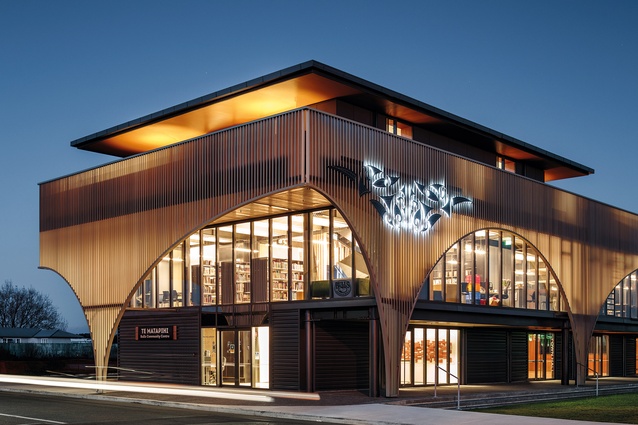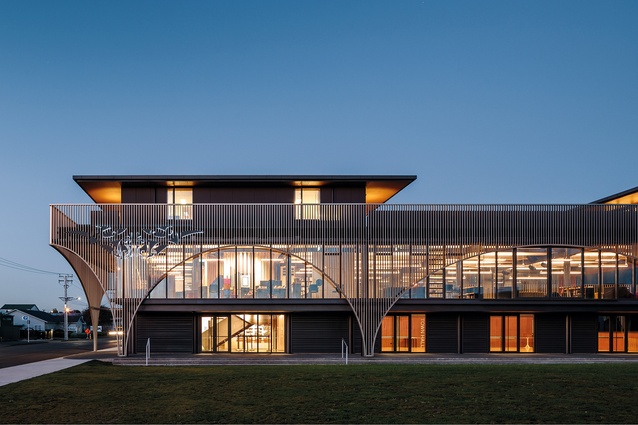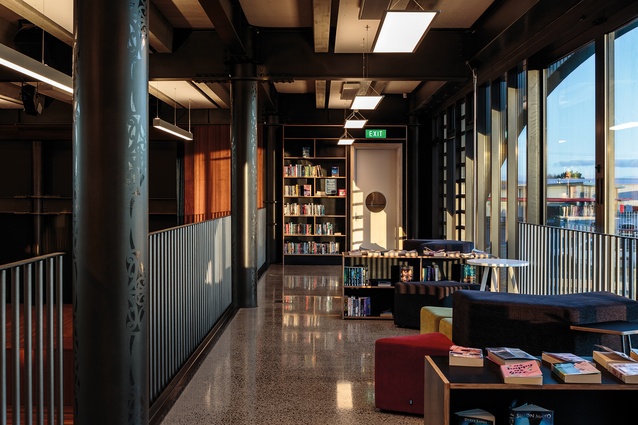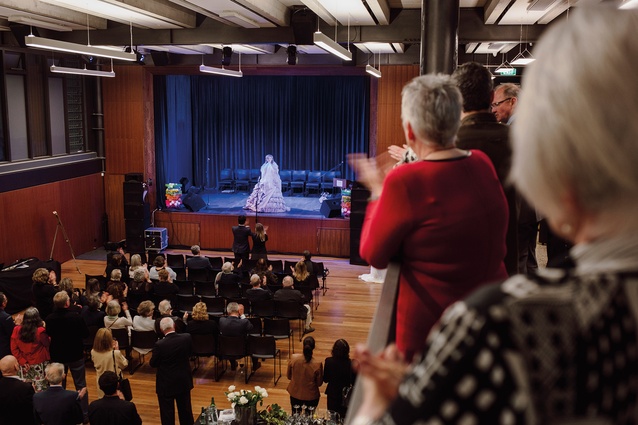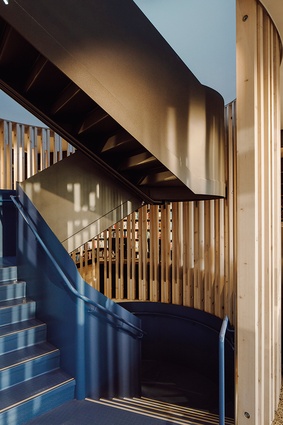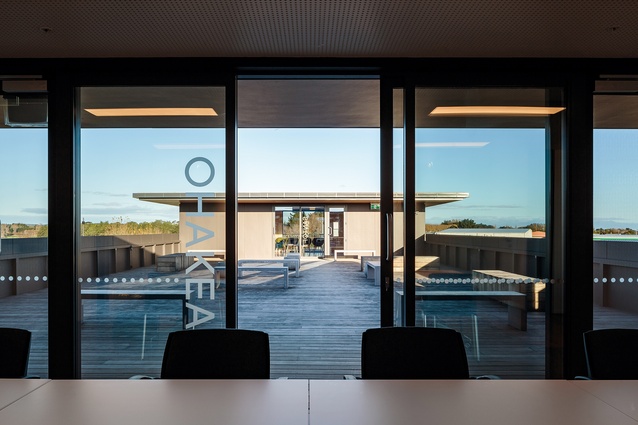A taniwha awakes
Felicity Wallace contemplates the Te Matapihi Bulls Community Centre by Architecture Workshop and finds a building full of wonderful ideas – some, such as its adjacent public square, yet to be completed.
Disclaimer: Felicity Wallace, BArch (Hons), is the Western Director of the Te Kāhui Whaihanga NZIA Board and a registered architect practising in New Zealand: she is based in Marton, a small town in the Rangitīkei district, not far from Bulls. She has more than 30 years’ experience in private practice and teaching design. In 2014, Felicity Wallace Architects was invited to submit a proposal for the preparation of a concept design and feasibility study for the proposed Bulls Community Centre but chose not to submit. Her partner, who is a business owner in Bulls, has been a vocal critic of the cost overruns on this project. The views in this review are personal and do not represent the views of the NZIA.
It’s pretty hard to make a building look like a bull without creating a cartoon figure. The Greeks literally constructed a horse to surprise their opponents and, centuries later, those Roman masters of the baroque, Bernini and Borromini, used perspective, light and reverse form to create a sense of movement in stone.
Watching this building take shape for some time has surprised me. Not many completed buildings look better than the perspectives that promote them. And not many buildings jump out at you, just as you think you’ve made it past the main intersection.
I’m not completely sure this is a building. I see it as a Pokémon, a transforming figure, a lure. It has the character of a bull, from the outside. Architect Chris Kelly sees it as a taniwha, a protector, embodying the spirit of the Rangitīkei River. The asymmetrical carapace of champagne aluminium glistens in changing light; it can look dull on grey days and then change again in the sun, creating shadows. It has a European aspect; I think of Chareau and Nouvel. At night, a veil, lit up, energised. The Pokémon, the taniwha, wakes up.
During the final months of construction, local iwi Ngāti Parewahawaha and Ngā Wairiki Ngāti Apa gifted the name Te Matapihi to the Rangitīkei District Council; it is translated as ‘a window to the future’.
It’s really a box with a screen – a carapace, veil, mask, that’s very beautiful. A very clever building, full of wonderful, exciting ideas. Not large, with a footprint of about 500m2, including the verandah, this pocket monster/box of tricks/treasure chest does many things.
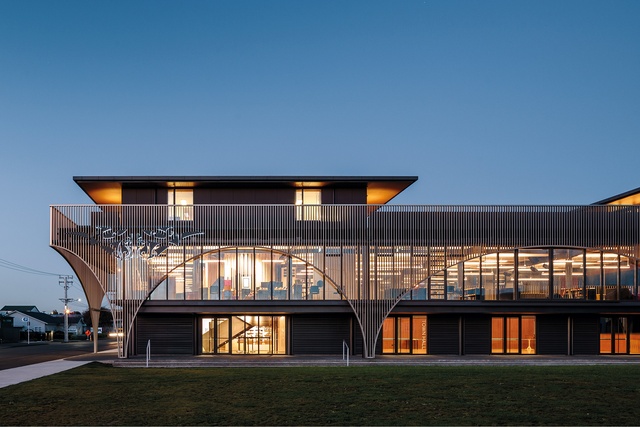
The Bulls community, while small, is diverse and includes local iwi, individuals and families who have lived in Bulls for many years, families connected to the Ōhakea Air Base, farming families and many newcomers seeing the opportunity to buy close to Palmerston North and Whanganui in a hot property market.
Around 2014, the Council decided to rebuild and combine the town hall, library, Plunket rooms and toy library, rather than strengthen and refurbish the existing buildings spread across the town. David Engwicht of Creative Communities International, based in Australia, whose website states he has no formal training as an urban planner, was engaged to prepare a Town Centre Plan.
The outcome was to abandon several distinctive buildings, including the Bulls Public War Memorial Library and the corrugated-iron-clad, shed-like original town hall, to create a new ‘civic heart’ and bring the facilities into one multifunctional building – “by sharing spaces, the building is far more flexible”.
The Council also formed a joint partnership with local private developers who planned to build a commercial building, including company offices, along the SH1/south-western side of the proposed square.
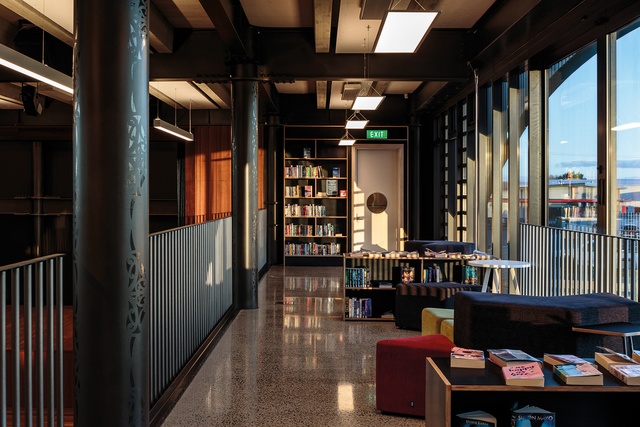
The Rangitīkei District Council was ambitious for the new Community Centre to become a landmark structure for Bulls, branded as “the gateway to the Rangitīkei district, with a dual role of providing facilities to the local community as well as a destination or reason to stop for travellers”.
The ambition to combine many uses within a small footprint brought challenges: in particular, how to combine specialist services, such as the library and visitor information, with community gathering spaces. Events such as the local rose show, school prizegivings, distribution of the Covid-19 vaccine and a large funeral have been held in the hall since it was completed.
Kelly says that the concept was for “an efficient little rectangle, as overlapping spaces, as small as we can… the first three-story building in Bulls”. Key to this concept was for the building to open onto the new public square so that the hall could become a stage, opening to the south-west.
The ceremonial access is quite lovely, via the verandah on the south-west; however, this is the least-sheltered side of the building so it is exposed to the prevailing westerly, the mean southerly and the road noise. This is an entrance that relies on a public square yet to be built.
The warm and sheltered north-east flank provides 24-hour access to public bathrooms; the consequent squeeze on the interior sacrifices ease of access for visitors and service deliveries.
Signage clearly suggests the main entrance to the Community Centre is from the street. This leads into an awkward space that feels more like a collection of objects dominated by a steel stair that obstructs any sense of clarity of direction. The i-Site is hidden in a corner. Once inside, it’s difficult to move around.
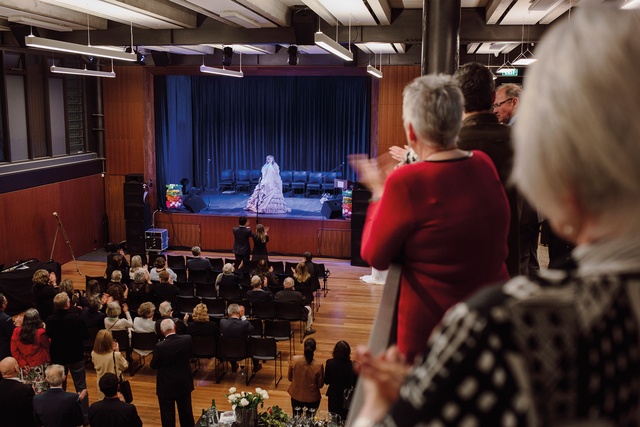
Individual spaces are beautifully crafted; the hall, especially, has a sense of richness – the proportions, material selection, sense of light and volume create a room both intimate and ceremonial. Long, loopy door-pulls link with soft, round columns; fixings are emphatic, shaped.
The first-floor library is cleverly laid out, combining well-lit open spaces that connect visually with the surrounding buildings and more-private, darkened spaces for computers and book display. The gallery leading on from the library creates an exhilarating connection with the hall below, while capturing a wide, urban view of the town beneath the curve of the carapace. This is the space for Romeo and Juliet.
Deeply recessed under floating roof canopies, the top floor seems strangely disconnected from the floors below. When I visited, two executives were working silently in separate rooms, swamped by space and focused completely on their screens, luxuriating in the peace. The township seemed a long way below and there was no view of the river. The top floor felt corporate and disengaged, with the obligatory large, glazed openings onto nature designed to impress.
The idea to maximise space by providing access to all sides of the building is inspired but, to be successful, the interior connections need to flow.
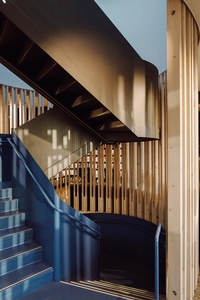
For Kelly, the stair is a metaphor for the river, connecting the new square to the new urban space of the rooftop. The stair is a strong blue; however, the steel sounds loud and feels cold. Despite high risers, the stair landing restricts access below.
From the exterior, the timber bonework framing the stairwell can be picked out by sunlight during the day and, like a fishhook, at night, the shape of the stairwell makes shadows.
The image is poetic but, I wonder, should the reference be to Tūtaeporoporo, the shark? Len Hetet (Ngāti Apa, Ngāti Tuwharetoa, Ngāti Maniapoto, Te Āti Awa) was commissioned during construction to look at “how Māori culture and mana whenua can be infused into the current architectural building and landscape typology for the Bulls Community Centre”.
Tūtaeporoporo was raised by Tū Ariki in a deep hole in the Rangitīkei River and is a very famous taniwha, who travelled to Whanganui to seek revenge for those who had killed Tū Ariki.
Hetet’s artworks provide a delicate, ethereal overlay to the structure of the carapace and the hall, and the proscenium arch framing the stage.
“There is a necessity to develop narrative from iwi that lays a foundation and helps give meaning to the artworks. Without the meaning, the artworks will have no life,” says Hetet. “The pattern represents the Rangitīkei land plains and the Rangitīkei River. It shows the coming together of people and the connection to the land and the waterways. The koru patterns above and below represent Ranginui and Papatūānuku.” I also see the impression of a matador’s cape.
Creating space that honours the treaty has to be about more than words or abstraction; each of us needs to feel the spirit of the space in our gut. How we first view the building, how we approach, how we enter and engage with the spaces, all need to be considered from more than one perspective. Individually, each space is beautiful; how these spaces intersect is problematic.
The Bulls township sits at a significant intersection of SH1 and SH3; the highways turn and combine at the Mansell’s Building, a moment of Edwardian density in a wide-open landscape. This crossing is known and regarded by locals for the risk it poses. It is difficult to cross the road at Bulls.
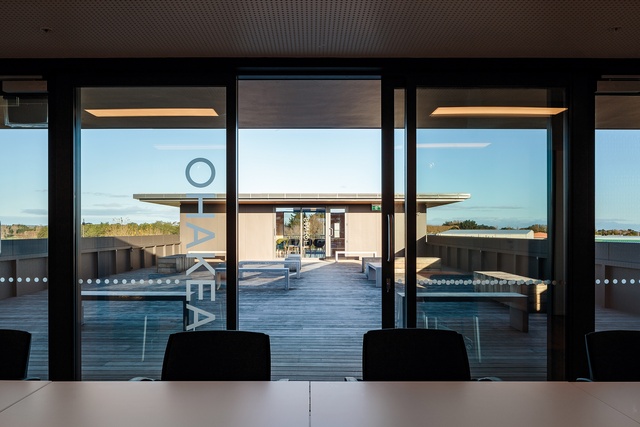
Central to the crossing of Te Matapihi is another problematic intersection. While there are alternative access doors from the verandah, the only interior access to the hall is a narrow, 1200mm width, with narrower doorways at each end. The only internal access to the bathrooms is almost directly facing a door to the kitchen. This is not only culturally offensive but also impractical.
There is no easy path within. From here, it’s not possible for two people to walk into this public hall at the same time. It just doesn’t work.*
Public buildings need to feel accessible, easy, friendly, considerate. They can also inspire us, as Te Matapihi certainly does. Te Matapihi may be a window, a signboard for a great dream. It is Bulls’ Opera House: exciting, problematic, challenging and, most definitely, a place of beginning, for a future where the relationship between tangata whenua and tangata tiriti can grow.
Again, I wonder… this bull is thin where it should be fat, and tall where it could put its head down. It could be a shark with a wide-open mouth.
*Before going to press, we received notification from the architect advising that an arrow was incorrectly placed on the floor during fit-out, indicating the way to the hall via a “back service door”. Signage is being improved to show the main entry route to the hall is via the verandah doors. – Editor

